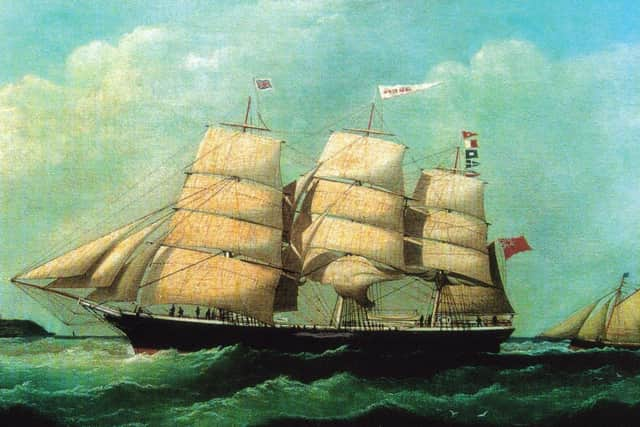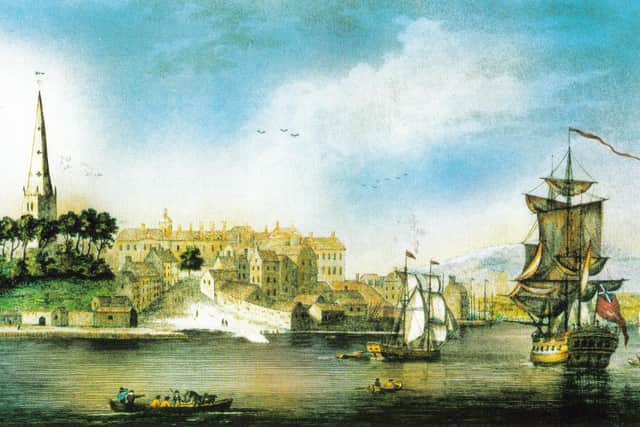The story of emigration from Derry in the age of sail and steam - Part 1
and live on Freeview channel 276
17th Century Emigration
Derry port possessed an ideal situation. She stood at the head of a virtually land-locked Lough Foyle, 24 miles long and only 2 miles wide at its head.
The Lough was sheltered from the prevailing westerly winds by the Inishowen peninsula, thus making it, in the age of sail, a harbour of refuge, accessible and safe in all weathers.
Advertisement
Hide AdAdvertisement
Hide Ad

Owing to her westerly situation Derry was seen as being halfway between London and the American colonies; a Derry ship “is no sooner out of the river, but she is immediately in the open sea and has but one course.”
Derry was, therefore, well placed to benefit from the emigration of Ulster people to North America. From about 1680 a trickle of emigrants arrived in the American colonies mainly from the Laggan (Donegal) and Foyle valleys (Derry and Tyrone). Links had been forged between the Foyle presbyteries and American Presbyterianism at the end of the 17th century. Rev. William Holmes returned to Ireland from New England in 1691 and was ordained minister of 1st Strabane in 1692 where he served until returning to New England in 1715. He was married to a daughter of Rev. Robert Craighead, minister of 1st Derry from 1690-1711, and their son Robert Holmes, captain of a merchant vessel, emigrated from Strabane in 1714.
18th Century Emigration
Between 1718 and the beginning of the War of American Independence in 1776, 250,000 Ulster-Scots – often referred to as Scotch-Irish or Scots-Irish in USA (i.e. descendants of 17th century Scottish Presbyterian settlers in the nine counties of the Province of Ulster: Antrim, Armagh, Down, Fermanagh, Derry, Tyrone , Cavan, Donegal and Monaghan) emigrated from Ireland through the ports of Belfast, Derry, Newry, Larne and Portrush for the British Colonies in North America.


The first step in what was to become a large-scale exodus of Ulster-Scots occurred in 1718 when one thousand disembarked at Boston from ten vessels which had departed from Derry and Coleraine.
Ship Conditions
Advertisement
Hide AdAdvertisement
Hide AdConditions on board 18th century emigrant ships were harsh. Disease thrived on overcrowded ships, with all emigrants accommodated, in communal berths, in the space between decks – the height between decks seldom exceeded 5 feet 6 inches; four feet six inches was common.


Port holes to provide ventilation and light were non-existent. Further hazards included storms, shipwreck and even capture by French and Spanish privateers.
By the 1770s the voyage across the Atlantic, on average, took 7 weeks with the fastest being 27 days by Jupiter to Philadelphia from Derry in 1772 and the slowest being 17 weeks by General Wolfe also to Philadelphia from Derry in the same year.
Isle of Islay
In the age of sail, the Isle of Islay, off the west coast of Scotland, was a long-standing hazard to ships attempting to enter or leave Lough Foyle in a storm, which as a rule blew in from the southwest.
Advertisement
Hide AdAdvertisement
Hide AdIn recognition of assistance given on numerous occasions to ships from Derry that encountered misfortune on the coast of Islay, Duncan Campbell was made, in 1748, an Honorary Freeman of the city.
The minute books of Londonderry Corporation (which can be viewed at https://www.nidirect.gov.uk/articles/londonderry-corporation-minute-books) of 12 January 1747 [1748 new style] instructed: “Duncan Campbell Esquire of Isla and Mr Thomas Knox Merchant of Sligoe have their tickets of freedom made out by the Chamberlain and sent to them…Ordered that Duncan Campbell Esquire have his freedom sent to him in a handsome silver box guilded with the City arms thereon for his great services done the ships belonging to this [port?] when they meet with any misfortunes on his coast.”
One hundred years later, the Exmouth departed Derry on 25 April 1847 for Quebec with 208 emigrants and it was wrecked off Islay with only three survivors (who were crew members). Passengers on the Exmouth were named in the Londonderry Journal of 12 May 1847 and a memorial was erected to them in Islay in 2000.
Philadelphia
Derry established itself as one of the chief Irish ports for transatlantic trade in the 18th century. Thirty percent of Ulster emigrants, around 75,000 people, departed through Derry port to North America prior to 1776 and the American Declaration of Independence.
Advertisement
Hide AdAdvertisement
Hide AdLinks between Derry and Philadelphia were established, through trade, in the 18th century.
Flaxseed, the raw material of the linen industry, was shipped to Derry from Philadelphia in the early spring, and on the return voyage linen and emigrants were destined for Philadelphia.
DERRY JOURNAL 250: What kind of Derry was the ‘Journal’ reporting on the day of June 3, 1772?With Parliament opening, in 1705, the American colonies to linen produced in Ireland, every facet of Ulster life became tied to the linen economy.
Flax was grown on very small farms, prepared and spun into linen yarn and woven into webs of cloth by families in their own homes, and sold in linen markets in towns to the linen drapers and bleachers who finished the linens and exported them. In the 18th century the domestic linen industry expanded so rapidly across the province that annual exports of linen cloth increased 40-fold.
Advertisement
Hide AdAdvertisement
Hide AdIn Ulster farmers grew flax for fibre which they could weave into cloth, so they purchased the best available seed each planting season.
From 1731 American flaxseed could be imported directly into Ireland. This cultivation of flax for seed made rural communities in Pennsylvania, New York and New England integral to the Ulster economy.
From the mid-1730s commercial networks quickly developed, linking the port towns of Ulster with a wider Atlantic world.
The men who managed this transatlantic commerce as merchants in New York, Philadelphia or Baltimore were members of the mercantile families of Belfast, Derry or Newry who shipped them linen and sent them orders for flaxseed or flour or proposals for a ship to be built.
Advertisement
Hide AdAdvertisement
Hide AdThe flaxseed ships consigned to these American merchants by their Ulster compatriots carried ‘passengers, redemptioners and servants’ on their outward voyage
This passenger trade was an increasingly important part of their business and the Belfast and Derry newspapers always had advertisements offering passage to America.
It is clear that strong trade links, reinforced by family connections in the mercantile community, developed in the 18th century between the ports of Derry and Philadelphia. Hugh Davey of Derry and Samuel Carsan of Strabane (Tyrone) were typical of Ulster-born merchants who pioneered, from the mid-1730s, in the flaxseed trade from Philadelphia, then the largest port in America.
A letter book of their correspondence survives in the Library of Congress which clearly shows that the networks they established reached across the Atlantic, linking Derry to Philadelphia and to the backcountry of Pennsylvania.
Advertisement
Hide AdAdvertisement
Hide AdDavey and Carsan shipped flaxseed and flour to Derry on the accounts of prominent merchants in both Derry and Strabane. Samuel Carsan owned at least 12 ships in partnership with merchants residing in Derry.
In 1764, Samuel’s nephew Thomas Barclay, from Strabane, and cousin William Mitchell, from Derry joined Samuel in a new Philadelphia firm, Carsan, Barclay and Mitchell which became one of the most important firms in the flaxseed and passenger trade. Derry merchants and ship-owners testified to the importance of their American trade. DERRY JOURNAL 250: First editor George Douglas’ ‘Journal’ reported on a time of revolutionary fermentA report of a committee of the Irish House of Commons in 1767 recorded that ’67 ships containing near 11,000 tons belong to the merchants of Derry.’
The Frontier
In the 18th century few inducements were able to overturn the Irish emigrants’ preferred destination of Philadelphia.
The 18th century Ulster emigrant tended to enter Colonial America through Philadelphia and then head for the frontier.
Advertisement
Hide AdAdvertisement
Hide AdIn the 1760s, however, the activities of land promoters/businessmen, with Ulster connections, encouraged Irish emigrants to consider, if only briefly, two alternative destinations to Philadelphia; namely, Nova Scotia and the Carolinas. Of 128 vessels advertised to sail from Derry between 1750 and 1775, 99 (77%) sailed for Philadelphia with 10 each destined for Charleston (in South Carolina) and Nova Scotia (Canada).
From Philadelphia the Ulster-Scots then poured across the Susquehanna into the Cumberland Valley. From the 1740s they moved southwards through the Great Valley, east of the Appalachian Mountains, across the Potomac and into the Shenandoah Valley between the Blue Ridge and Appalachian ranges. From there they continued south into the Carolinas.
By the Revolutionary War, in 1776, about 90% of Ulster settlers had made their homes in Pennsylvania, the Valley of Virginia and the Carolinas; and they dominated a one-thousand-mile frontier along the spine of Appalachia from Pennsylvania to South Carolina.
With the War of American Independence over the Ulster-Scots then spearheaded the first thrusts across the Appalachian range, through the Cumberland Gap, into Kentucky and Tennessee.
19th Century Emigration
Advertisement
Hide AdAdvertisement
Hide AdThere is still a tendency to see the Famine of 1846 to 1851, when over a million people left Ireland for North America, as the cause of the Irish Diaspora. In reality heavy emigration from Ireland began well before the Famine and continued well after it.
With the end of the Napoleonic Wars in 1815 many small farmers, agricultural labourers and rural tradesmen in Ireland saw emigration as the only solution to their declining economic prospects.
Emigration thus acted as a “safety valve,” enabling young men and women with little economic prospects to escape Ireland.
Derry’s importance as an emigration port continued to grow in the 19th century; it was a profitable trade.
Advertisement
Hide AdAdvertisement
Hide AdMerchants in Derry soon became ship-owners as opposed to agents for American and British companies.
An outward cargo of emigrants, a homeward cargo of timber or grain, together with two voyages per year, one in spring and one in the autumn, ensured a sizeable profit.
By 1833 seven merchants in the city – Daniel Baird, James Corscaden, John Kelso, William McCorkell, James McCrea, John Munn and Joseph Young – owned fifteen vessels, all engaged in the North American emigrant trade.
Advertisement
Hide AdAdvertisement
Hide AdSaint John (New Brunswick) and Quebec in Canada, and New York and Philadelphia in the United States were the destination ports of emigrants departing from Derry in the first half of the 19th century.
Of 38 emigrant ships advertised to sail from Derry in 1836: 12 were destined for Saint John (New Brunswick), 12 for Philadelphia, 7 for Quebec and 6 for New York.
J & J Cooke
By the 1850s, two local companies, J & J Cooke and William McCorkell & Co., dominated transatlantic trade and, in the process, built up sizeable shipping fleets.
In 1837 John Cooke and his brother Joseph began a partnership that lasted until John Cooke’s death on 25 February 1895. Between 1847 and 1867 J & J Cooke carried 22,199 passengers to North America. In this period the firm bought nine ships specifically for the emigration trade.
Advertisement
Hide AdAdvertisement
Hide AdAt the height of the Famine in 1847, of 12,385 emigrants leaving from Derry, 5,104 or 41% were carried by J & J Cooke in 20 ships; 8 of these ships were destined for Philadelphia, 7 for Saint John, New Brunswick and 5 for Quebec. Prior to the 1860s, and the establishment of a railway network in Ireland, the port of Derry served as the emigration port for Derry, Donegal and Tyrone.
An examination of the order book of J & J Cooke, for 1850, confirms that 88% of passengers carried on their ships came from these three counties; with 40% from Donegal, 26% from Tyrone and 22% from Derry.
Part 2 - Next Friday.
Brian Mitchell’s booklet ‘Derry~Londonderry: Gateway To A New World’ is available at the Tower Museum and the Guildhall.
